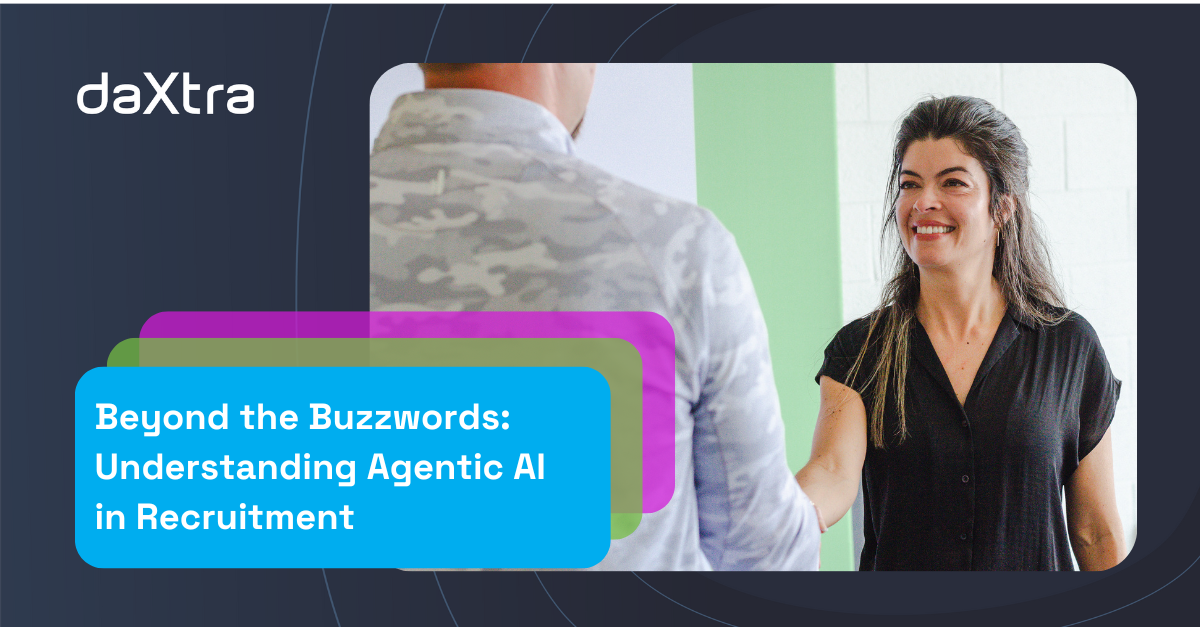Recruitment professionals are constantly bombarded with new technological terms and promises of AI solutions that will solve all their hiring challenges. Yet many are left wondering what actually works and what's just marketing hype.
One term you've likely heard is "Agentic AI." But what exactly does it mean, and how is it different from the AI tools you may already be using?
In a recent webinar, "Smart Tech, Smart Hires: How Science Drives Daxtra Technology," our CTO Don Tomlinson and VP of Customer Success Colleen Barraclough broke down the science behind AI in recruitment technology. They explained what makes truly intelligent systems different from basic automation that's simply labeled as "AI."
This blog post distills key insights from that discussion to help you understand what Agentic AI really is, how it’s impacting recruitment search technology, and why it all matters for your daily work.
In this post:
- What is agentic AI?
- AI vs. Automation: How to spot “AI Washing”
- Evolution of Search Technology: Meet Vector Embeddings
- How Vector Embeddings Power Modern AI
- Real World Applications of Agentic AI in Recruitment
What is agentic AI?
AI has evolved dramatically over the decades. From simple Boolean searches to keyword matching to semantic understanding, recruitment technology has made significant leaps in functionality. But Agentic AI represents something fundamentally different.
Don Tomlinson explains: "Agentic AI has the ability to act on behalf of users. It's proactive, it's context aware, and it's continuously improving through feedback loops."
Unlike basic automation tools that follow predefined rules, Agentic AI can:
- Take initiative without explicit step-by-step instructions
- Understand and adapt to different contexts
- Make decisions based on patterns it has learned
- Complete multi-step processes independently
- Improve over time through feedback
AI vs. Automation: Spotting "AI Washing"
Many products claim to use AI when they're really just automated tools following simple rules. This practice, called "AI washing," can make it difficult to identify solutions with genuine AI capabilities.
Here's how to tell the difference:
Automation:
- Follows predefined rules
- Performs repetitive tasks exactly the same way each time
- Cannot adapt beyond its programming
- Example: An email filter that automatically sends messages from specific senders to designated folders
True AI:
- Learns from data and improves over time
- Adapts to new situations
- Makes context-aware decisions
- Example: A system that can understand that "Python" in a developer resume refers to a programming language, not a snake
Quick Quiz: Agentic or Automation?
Let's test your understanding with a few practical examples. Are these hypothetical tools leveraging Agentic AI, or using basic automation? (Answers below)
- A scheduling tool that suggests interview times based on calendar availability.
- A screening chat assistant that creates custom questions for candidates and texts them automatically.
- A new hire onboarding assistant that guides employees through paperwork and answers their questions in real time
Answers:
- Not Agentic
This tool uses AI to understand calendars but doesn't act independently. If it automatically scheduled interviews based on learned preferences, it would be Agentic. - Agentic
This is Agentic because it determines appropriate questions for each candidate and takes action to screen them without human intervention. - Agentic
This qualifies as Agentic because it guides users through a workflow and can respond adaptively to their questions.
The Evolution of Recruitment Search Technology
Recruitment search technology has come a long way in the last 20 years. Colleen Barraclough, VP of Customer Success, has seen this firsthand:
"After 25 years in recruiting and 10 years at Daxtra, I've watched our industry evolve through multiple generations of search technology,” she said. “What we're seeing now with vector embeddings and Agentic AI feels very different. It's the breakthrough we've been waiting for."
Previous generations of search technology can be broken down into three categories:
Boolean Search
- Complex syntax with AND, OR, NOT operators
- Unforgiving of mistakes
- Some studies show that even experienced recruiters can miss 40-60% of qualified candidates by relying on Boolean search
Keyword Search
- Simpler to use, but matches in a more literal sense
- Led to candidate keyword stuffing on resumes
- Surface-level matching at best
Semantic Search
- Understands related concepts and synonyms
- Connects terms with synonyms that don't exactly match - like "project manager" with "program manager"
- Can lack personalized context for specific roles
This path has led us to the latest iteration of search technology: conversational search.
Conversational Search
- Can lack personalized context for specific roles
- Allows natural language queries
- Understands intent and context
- Can be refined through conversation
- Finds candidates that would be missed by other methods
How Vector Embeddings Power Modern AI
The science behind modern AI recruitment tools involves a concept called vector embeddings. Don Tomlinson explains this with a helpful visualization:
"Imagine every candidate resume represented by a pin on a world map. The east-west position might represent work experience, while north-south represents skills. Resumes with similar skills and experience would be clustered close together on this map."
Vector embeddings work by:
- Converting words and concepts into numerical values (vectors)
- Placing similar concepts near each other in multidimensional space
- Understanding context beyond exact keyword matches
- Finding "nearby" candidates when you search for specific skills or experience
Keyword matching relies on exactly matching keywords, while vector matching matches similar content in a 3-dimensional space.
This approach means a search for "software engineer" can find relevant "full stack developers" even if those exact words don't appear, because their vector representations are similar.
You’ve probably seen this tech at work in your day-to-day life - for instance, it’s similar to how Netflix recommends movies. As Colleen puts it:
"Netflix uses vector embeddings for their movies and everything associated with them. They've assigned numbers to various movies, so when you watch one, it becomes the input query with all its associated numbers. When it makes suggestions to you, it's using vector embeddings to present that information back,” she said.
When looking at how accurate these systems are, Daxtra uses multiple metrics:
- Mean Average Precision (MAP): How accurately we rank candidates across multiple queries
- Mean Reciprocal Rank (MRR): How quickly the first relevant match appears
- Precision and Recall: Finding the right balance between false positives and negatives
- Normalized Discounted Cumulative Gain (NDCG): Evaluating the entire ranking holistically
Real-World Applications in Recruitment
Agentic AI and vector embeddings are transforming recruitment workflows in several ways:
Conversational Search
Instead of building complex Boolean strings, recruiters can simply describe what they're looking for: "I need a software engineer in Orlando with 5 years of Java experience in financial services, and no job-hopping."
Intelligent Candidate Matching
The system understands that a Java developer with AWS experience might be an excellent match for a "backend engineer" role, even without exact terminology matches.
Automated Screening
An Agentic AI can create custom screening questions based on gaps between a resume and job description, then conduct the screening automatically.
Candidate Summaries and Explanations
AI can generate summaries of why a candidate scored well for a position, making the matching process transparent and explainable.
Don Tomlinson emphasized the importance of explainability: "When people ask me when should I trust AI and when should I not, for me, I can trust AI when I can explain it. Part of that is giving each of you explainability within why we're a match."
Why Recruiters Should Care
The practical benefits of these technologies address common recruitment challenges:
- Time Savings: Find relevant candidates faster without building complex search strings
- Better Candidate Discovery: Uncover qualified candidates who would be missed by traditional methods
- Reduced Bias: Focus on skills and experience rather than exact keyword matches
- Transparency: Understand why candidates are matched to positions
- Candidate Experience: Create more relevant interactions with potential hires
In particular, these technologies excel at finding candidates who might have been overlooked by traditional methods. As Colleen pointed out, "We're able to bring candidates that meet your criteria, then also suggest candidates based off of what we know from a technological perspective with the AI that is going to be important to you."
For example, when searching for a VP of Engineering, conversational AI can understand the context of what you're looking for beyond just the job title. It might identify candidates who have the necessary experience but haven't held that exact title yet.
Looking Forward
Vector embeddings and Agentic AI represent significant advancements in recruitment technology, but their real value comes from how they solve everyday problems for recruitment professionals.
The evolution from Boolean to keyword to semantic and now to conversational search reflects a growing sophistication in how we match people to opportunities. Each generation has built upon the last, with Agentic AI representing the most recent step forward.
For recruiters working with multilingual candidates, there's good news too. As Don Tomlinson explained: "A Java developer in English has basically the same numerical vectors as a Java developer in German, and it has the same vectors as a Java developer in French."
These technologies don't aim to replace human recruiters but rather to handle repetitive tasks and surface insights that might otherwise be missed. The goal is to let recruiters focus on what they do best: building relationships and making nuanced hiring decisions.
Understanding the difference between true AI and "AI washing" is crucial as you evaluate recruitment tools. By knowing what genuine Agentic AI can do, you can make better decisions about the technology you use and avoid solutions that promise AI capabilities but deliver only basic automation.
Whether you're sourcing candidates, screening applicants, or matching people to roles, these technologies can help you work more effectively while finding better matches for your open positions.



